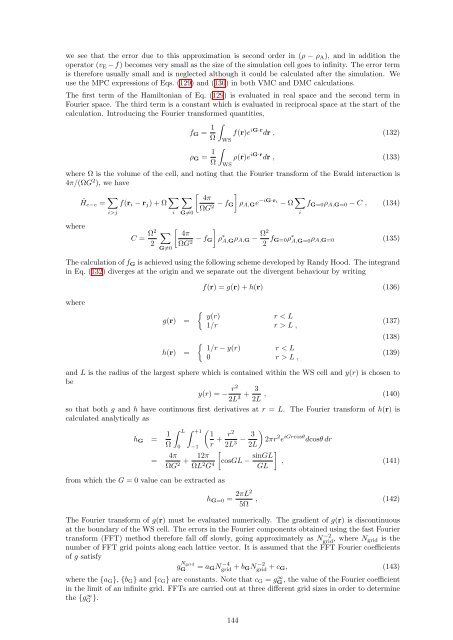CASINO manual - Theory of Condensed Matter
CASINO manual - Theory of Condensed Matter
CASINO manual - Theory of Condensed Matter
You also want an ePaper? Increase the reach of your titles
YUMPU automatically turns print PDFs into web optimized ePapers that Google loves.
we see that the error due to this approximation is second order in (ρ − ρ A ), and in addition the<br />
operator (v E − f) becomes very small as the size <strong>of</strong> the simulation cell goes to infinity. The error term<br />
is therefore usually small and is neglected although it could be calculated after the simulation. We<br />
use the MPC expressions <strong>of</strong> Eqs. (129) and (130) in both VMC and DMC calculations.<br />
The first term <strong>of</strong> the Hamiltonian <strong>of</strong> Eq. (129) is evaluated in real space and the second term in<br />
Fourier space. The third term is a constant which is evaluated in reciprocal space at the start <strong>of</strong> the<br />
calculation. Introducing the Fourier transformed quantities,<br />
f G = 1 ∫<br />
f(r)e iG·r dr , (132)<br />
Ω<br />
ρ G = 1 Ω<br />
∫<br />
WS<br />
WS<br />
ρ(r)e iG·r dr , (133)<br />
where Ω is the volume <strong>of</strong> the cell, and noting that the Fourier transform <strong>of</strong> the Ewald interaction is<br />
4π/(ΩG 2 ), we have<br />
Ĥ e−e = ∑ f(r i − r j ) + Ω ∑ ∑<br />
[ ] 4π<br />
ΩG 2 − f G ρ A,G e −iG·ri − Ω ∑ f G=0 ρ A,G=0 − C , (134)<br />
i>j<br />
i<br />
i<br />
G≠0<br />
where<br />
C = Ω2<br />
2<br />
∑<br />
G≠0<br />
[ ] 4π<br />
ΩG 2 − f G ρ ∗ A,Gρ A,G − Ω2<br />
2 f G=0ρ ∗ A,G=0ρ A,G=0 (135)<br />
The calculation <strong>of</strong> f G is achieved using the following scheme developed by Randy Hood. The integrand<br />
in Eq. (132) diverges at the origin and we separate out the divergent behaviour by writing<br />
f(r) = g(r) + h(r) (136)<br />
where<br />
g(r) =<br />
h(r) =<br />
{ y(r) r < L<br />
1/r r > L ,<br />
{<br />
1/r − y(r) r < L<br />
0 r > L ,<br />
(137)<br />
(138)<br />
(139)<br />
and L is the radius <strong>of</strong> the largest sphere which is contained within the WS cell and y(r) is chosen to<br />
be<br />
y(r) = − r2<br />
2L 3 + 3<br />
2L , (140)<br />
so that both g and h have continuous first derivatives at r = L. The Fourier transform <strong>of</strong> h(r) is<br />
calculated analytically as<br />
h G = 1 Ω<br />
∫ L ∫ +1<br />
0<br />
= 4π<br />
ΩG 2 +<br />
from which the G = 0 value can be extracted as<br />
−1<br />
( 1<br />
r + r2<br />
2L 3 − 3 )<br />
2πr 2 e iGrcosθ dcosθ dr<br />
2L<br />
]<br />
12π [<br />
ΩL 2 G 4 cosGL − sinGL<br />
GL<br />
, (141)<br />
h G=0 = 2πL2<br />
5Ω , (142)<br />
The Fourier transform <strong>of</strong> g(r) must be evaluated numerically. The gradient <strong>of</strong> g(r) is discontinuous<br />
at the boundary <strong>of</strong> the WS cell. The errors in the Fourier components obtained using the fast Fourier<br />
transform (FFT) method therefore fall <strong>of</strong>f slowly, going approximately as N −2<br />
grid , where N grid is the<br />
number <strong>of</strong> FFT grid points along each lattice vector. It is assumed that the FFT Fourier coefficients<br />
<strong>of</strong> g satisfy<br />
g N grid<br />
G<br />
= a G N −4<br />
grid + b GN −2<br />
grid + c G, (143)<br />
where the {a G }, {b G } and {c G } are constants. Note that c G = g ∞ G , the value <strong>of</strong> the Fourier coefficient<br />
in the limit <strong>of</strong> an infinite grid. FFTs are carried out at three different grid sizes in order to determine<br />
the {g ∞ G }. 144

















